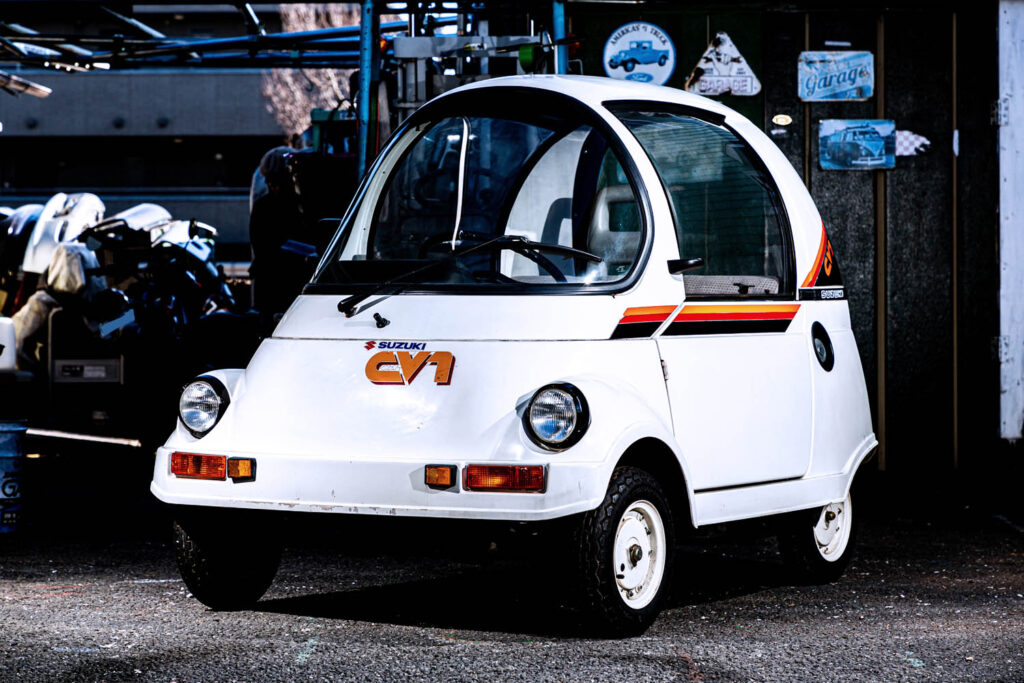A single-seat 50cc moped car put on the market by Suzuki in 1981
When people think of the ‘most basic car’ in Japan, they generally think of kei cars, but there is a category of micro cars and moped cars that are even more minimal transporters than that class. The Suzuki CV1 is introduced here. It is a one-seater compact car with a displacement of 50 cc, marketed in 1981 by Suzuki, which is also known as the top manufacturer of kei-cars.
It was Suzuki’s next move after the success of the first-generation Alto
The creation of the minimal transporter in the first place was often heavily influenced by the historical background. For example, during World War II, small electric cars and pedal cars were made in Nazi Germany-occupied France, and after the war, primitive small cars and bubble cars sprang up like bamboo shoots after rain, mainly in defeated countries such as Germany, Italy and Japan. …… and so on.
Many of these were necessitated by a period of resource scarcity and enduring deprivation. The Japanese moped car, which was seen in large numbers around 1980, could also be said to be a vehicle or genre born out of the trends of the times.
The Fourth Middle East War of 1973 and the Iranian Revolution of 1979, each of which led to two oil crises in the 1970s. The huge rise in oil prices had a major impact not only on Japan but also on the rest of the world. It was around this time that words such as “energy-saving” and “resource-saving” came into use.
In 1979, the Suzuki Alto made its debut in the world of light cars, which until then had been so busy with excessive luxury and power competition that they had almost forgotten what they were really about: cheap, light, and convenient. The Alto, which returned to the origins of the kei car, was a huge hit, and it seemed to change the tide of the Japanese kei car scene at once. Suzuki, which advocated “small car, big future”, was prepared to take a further step. This was the Suzuki Community Vehicle CV1, which was exhibited at the 24th Tokyo Motor Show in 1981.
Developed as a simple and inexpensive vehicle, smaller and simpler than a kei-car
According to Suzuki’s documentation at the time, the CV1 “was prototyped as an all-weather vehicle that can be used safely and securely by family bike users, with an eye on the state of vehicles in urban and rural areas, traffic congestion and energy conservation issues”.
The development concept includes statements such as “fuel economy of 50 km/liter, easy operation for everyone, 1/4 the weight of a mini car, half the parking space of a mini car, and a low price with no waste that anyone can easily afford”.
The legal definition of a moped car, incidentally, is an ordinary vehicle with a displacement of 50 cc or less or a motor with a rated output of 0.6 kW or less, and its size is 2.5 m in length, 1.3 m in width and 2 m in height or less. Of course, this CV1 is also kept under those dimensions (length 1900 mm x width 1180 mm x height 1280 mm) and is powered by a 3.5 hp air-cooled two-stroke 49.9 cc engine for the company’s 50 cc scooter, the Gemma.
This was a model that motorcycle/four-wheel manufacturer Suzuki was serious about
After the oil crisis, when “energy saving” became one of the keywords, many moped car manufacturers were in the fray, and among them, there were some primitive moped cars that simply used components from commercially available moped scooters and covered them with FRP bodies, but this CV1 was a model seriously produced by motorcycle/four-wheel manufacturer However, the CV1 was a model seriously developed by Suzuki, and its level of perfection was extremely high.
After its unveiling at the Tokyo Motor Show, the CV1 went on sale with minor improvements, including the redesign of the single square headlight to a two-lamp round type.
Suzuki had planned to promote it as an all-weather scooter-like vehicle that could be ridden with a moped license, but due to changes in the law, a regular license was required to drive a moped car, and the situations in which it could be used were still limited when compared to mini cars. Despite its enthusiasm, it failed to become a city commuter for the new era.
In the end, Suzuki withdrew from the moped car market with the CV1 as its first and last production moped car. The actual number of units marketed is said to have been around 100 between 1981 and 1985, according to one theory.
CV1 carefully maintained by a collector
Although the Suzuki CV1 rarely appears in used car dealerships or private sales, it is now rarely seen, but it has become a cult favorite among some enthusiasts due to its rarity and as a historical witness to the ‘moped car era’ of today.
The machine we are showing here is also a cherished piece of work owned by Mr Kiyoshi Nakamura, an avid microcar enthusiast. The owner, Mr Nakamura, is a well-known figure in the world of mopeds, having owned many other mopeds in addition to this CV1 and has been interviewed many times by car magazines.
Of course, when we visited him for the interview, there were many other moped cars in his garage besides the CV1, which we will introduce again, along with Mr Nakamura’s episodes.
translated by DeepL
